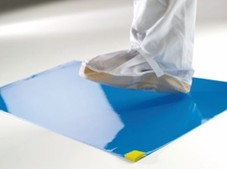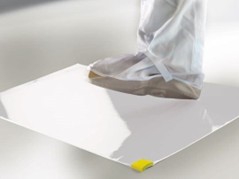- 2025
- 2024
- 2023
- 2020
- 2018
Adhesive Mats in Cleanroom Environments: A Practical Guide
Adhesive mats (also known as sticky mats) are used to reduce particulate contamination brought in by shoes and wheels. When positioned and maintained properly, they serve as an effective first line of defense at cleanroom entry points.
Why Not Call Them “Tacky Mats”?
“Tacky Mat” is a trademarked term (Liberty Industries), so the industry uses “adhesive mat” or “sticky mat” instead. The purpose remains the same: trapping debris before it enters controlled areas.
Purpose of Adhesive Mats
These mats capture floor-borne particles, especially:
• At entrances to gown rooms or clean zones
• In high-traffic transition areas
Their use helps prevent contaminants from migrating into clean environments via foot traffic or equipment wheels.
Alternatives to Mats
Many facilities reduce adhesive mat use by implementing:
• Cleanroom-only footwear
• Wheel cleaning or taping protocols
• Shoe cleaning systems or brush stations
• Fiber mats before adhesive mats
These methods address contamination earlier in the process.
Types of Adhesive Mats
Disposable Mats:
Multi-layered; peel away used layers to expose a clean surface. Ideal for gown room thresholds.
Permanent Mats:
These mats are reusable and use van der Waals forces to trap particles. They reduce contamination by up to 99.8% from feet and 99.4% from wheels. They’re ideal for high-traffic cleanroom areas and need minimal upkeep.
Placement & Sizing
• Place mats lengthwise in walking direction to ensure 2–3 full steps on the mat.
• Minimum size: 18” x 36”. Use larger sizes or multiple mats for wide doorways.
• Avoid placing mats sideways across entrances—users may step around them.


Color & Visibility
• White mats are ideal for critical areas (e.g., nano or sterile environments) where contamination must be visible.
• Blue or clear mats are common in general cleanrooms.
Installation Tips
• Clean and dry the floor thoroughly before installing.
• Use a roller to press the mat down evenly and remove air bubbles.
• For uneven surfaces, use a mat frame.
Removing Layers
Peel layers slowly or roll them up to prevent static generation. Fast peeling can cause a triboelectric charge, attracting particles to the mat instead of removing them.
Maintenance
Disposable mats: Replace the top sheet when visibly dirty or after heavy traffic.
Permanent mats: Clean with detergent and allow to dry thoroughly—this may be needed several times daily in busy zones.
Common Pitfalls
• Lifting corners: Poor surface prep or trapped air
• Overly sticky mats: Excess adhesive buildup
• Missed contamination: Improper size or placement allowing users to step around mats
Summary
Adhesive mats are effective for capturing contaminants before they enter cleanrooms, but only when sized, placed, and maintained correctly. They work best alongside other controls like clean footwear, wheel cleaning, and floor preparation.
For validated adhesive mat solutions and cleanroom-compatible designs, visit www.texwipe.com or contact a rep here.
